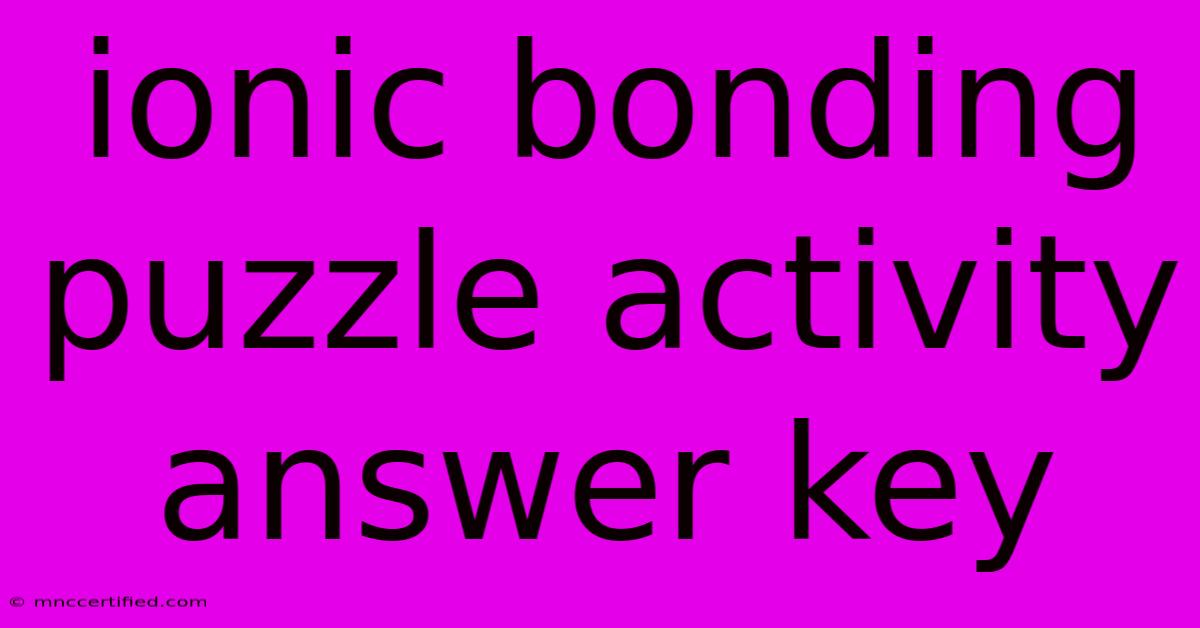Ionic Bonding Puzzle Activity Answer Key

Table of Contents
Unlocking the Secrets of Ionic Bonding: A Puzzle Activity Answer Key
Ionic bonding, the electrostatic attraction between oppositely charged ions, is a fundamental concept in chemistry. To help students grasp this concept, educators often employ interactive activities like puzzles. This article provides an answer key to a common ionic bonding puzzle, along with tips for making the most of this educational tool.
The Puzzle:
The puzzle typically presents a set of ions (cations and anions) and their corresponding charges. Students must then match the ions to form stable ionic compounds, considering the principle of electroneutrality. This means the overall charge of the compound must be zero.
Answer Key:
Here's a sample answer key for a common ionic bonding puzzle, featuring the following ions:
- Cations: Na+, K+, Mg2+, Ca2+, Al3+
- Anions: Cl-, Br-, O2-, S2-, N3-
Matching the Ions:
| Cation | Anion | Formula |
|---|---|---|
| Na+ | Cl- | NaCl |
| K+ | Br- | KBr |
| Mg2+ | O2- | MgO |
| Ca2+ | S2- | CaS |
| Al3+ | N3- | AlN |
Explanation:
- NaCl (Sodium Chloride): One sodium ion (Na+) with a +1 charge combines with one chloride ion (Cl-) with a -1 charge, resulting in a neutral compound.
- KBr (Potassium Bromide): One potassium ion (K+) with a +1 charge combines with one bromide ion (Br-) with a -1 charge, resulting in a neutral compound.
- MgO (Magnesium Oxide): One magnesium ion (Mg2+) with a +2 charge combines with one oxide ion (O2-) with a -2 charge, resulting in a neutral compound.
- CaS (Calcium Sulfide): One calcium ion (Ca2+) with a +2 charge combines with one sulfide ion (S2-) with a -2 charge, resulting in a neutral compound.
- AlN (Aluminum Nitride): One aluminum ion (Al3+) with a +3 charge combines with one nitride ion (N3-) with a -3 charge, resulting in a neutral compound.
Tips for Using the Puzzle Effectively:
- Visual Representation: Encourage students to draw Lewis dot structures of the ions to visualize the transfer of electrons and formation of ionic bonds.
- Real-World Connections: Discuss the uses of the formed ionic compounds, like table salt (NaCl), to make the learning more relevant.
- Challenge Extension: Introduce polyatomic ions (like sulfate, SO42-) to increase the complexity of the puzzle.
- Interactive Platforms: Consider using online interactive platforms or virtual reality tools to enhance the puzzle experience.
Conclusion:
Ionic bonding puzzles are an engaging and effective way to teach students about this crucial concept. By providing clear answers, engaging visuals, and relevant connections, educators can solidify students' understanding of ionic bonding and prepare them for further chemical explorations.

Thank you for visiting our website wich cover about Ionic Bonding Puzzle Activity Answer Key. We hope the information provided has been useful to you. Feel free to contact us if you have any questions or need further assistance. See you next time and dont miss to bookmark.
Featured Posts
-
Insurance Companies In Okeechobee Florida
Nov 07, 2024
-
Cardiff City Team News Luton Town Clash
Nov 07, 2024
-
Jim Simpson Insurance Carbondale Illinois
Nov 07, 2024
-
How To Start A Real Estate Investment Firm
Nov 07, 2024
-
Us Health Insurance For Canadian Students
Nov 07, 2024